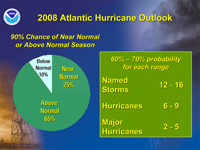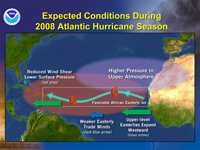NOAA Predicts Near Normal or Above Normal Atlantic Hurricane Season
As With Any Season, Preparation is Essential

The National Oceanic and Atmospheric Administration's Climate Prediction Center today announced that projected climate conditions point to a near normal or above normal hurricane season in the Atlantic Basin this year. The prediction was issued at a news conference called to urge residents in vulnerable areas to be fully prepared for the onset of hurricane season, which begins June 1.
"Living in a coastal state means having a plan for each and every hurricane season. Review or complete emergency plans now - before a storm threatens," said retired Navy Vice Adm. Conrad C. Lautenbacher, Ph.D., undersecretary of commerce for oceans and atmosphere and NOAA administrator. "Planning and preparation is the key to storm survival and recovery."
The Climate Prediction Center outlook calls for considerable activity with a 65 percent probability of an above normal season and a 25 percent probability of a near normal season. This means there is a 90 percent chance of a near or above normal season.
The climate patterns expected during this year's hurricane season have in past seasons produced a wide range of activity and have been associated with both near-normal and above-normal seasons. For 2008, the outlook indicates a 60 to 70 percent chance of 12 to 16 named storms, including 6 to 9 hurricanes and 2 to 5 major hurricanes (Category 3, 4 or 5 on the Saffir-Simpson Scale).
An average season has 11 named storms, including six hurricanes for which two reach major status.
"The outlook is a general guide to the overall seasonal hurricane activity," Lautenbacher said. "It does not predict whether, where or when any of these storms may hit land. That is the job of the National Hurricane Center after a storm forms."
Bill Read, director of NOAA's National Hurricane Center, said, "Our forecasters are ready to track any tropical cyclone, from a depression to a hurricane, which forms in the Atlantic Basin. We urge coastal residents to have a hurricane plan in place before the season begins and NHC will continue to provide the best possible forecast to the public."
When a storm forms in the tropics - and even before that stage - NOAA forecasters at the Miami-based National Hurricane Center are in continuous monitoring mode - employing a dense network of satellites, land- and ocean-based sensors and aircraft reconnaissance missions operated by NOAA and its partners. This array of data supplies the information for complex computer modeling and human expertise that serves the basis for the hurricane center's track and intensity forecasts that extend out five days in advance.
The science behind the outlook is rooted in the analysis and prediction of current and future global climate patterns as compared to previous seasons with similar conditions.
"The main factors influencing this year's seasonal outlook are the continuing multi-decadal signal (the combination of ocean and atmospheric conditions that have spawned increased hurricane activity since 1995), and the anticipated lingering effects of La Niña," said Gerry Bell, Ph.D., lead seasonal hurricane forecaster at NOAA's Climate Prediction Center. "One of the expected oceanic conditions is a continuation since 1995 of warmer-than-normal temperatures in the eastern tropical Atlantic."

"Americans in hurricane-prone states must get serious and be prepared. Government - even with the federal, tribal, state and local governments working perfectly in sync - is not the entire answer. Everyone is part of the emergency management process," said FEMA Administrator R. David Paulison. "We must continue to develop a culture of preparedness in America in which every American takes personal responsibility for his or her own emergency preparedness."
NOAA's Atlantic hurricane season outlook will be updated on August 7, just prior to what is historically the peak period for hurricane activity.
Tropical systems acquire a name - the first of which for 2008 will be Arthur - upon reaching tropical storm strength with sustained winds of at least 39 mph. Tropical storms become hurricanes when winds reach 74 mph, and become major hurricanes when winds reach 111 mph.
The National Oceanic and Atmospheric Administration, an agency of the U.S. Commerce Department, is dedicated to enhancing economic security and national safety through the prediction and research of weather and climate-related events and information service delivery for transportation, and by providing environmental stewardship of our nation's coastal and marine resources. Through the emerging Global Earth Observation System of Systems (GEOSS), NOAA is working with its federal partners, more than 70 countries and the European Commission to develop a global monitoring network that is as integrated as the planet it observes, predicts and protects.
 Deep Sea Crabs
Deep Sea Crabs